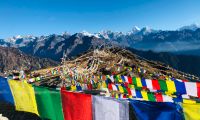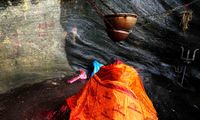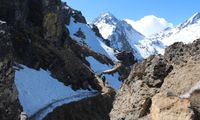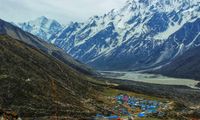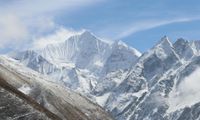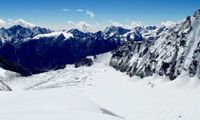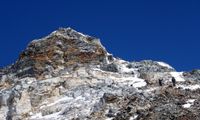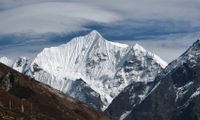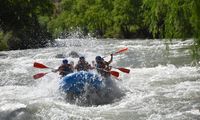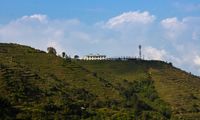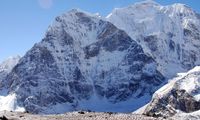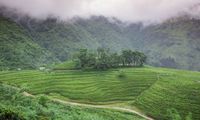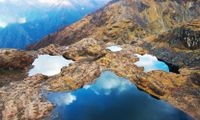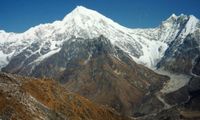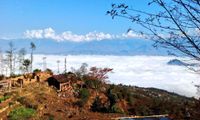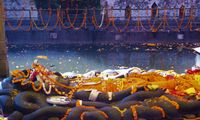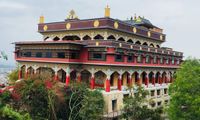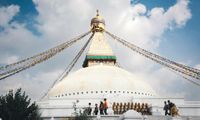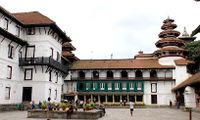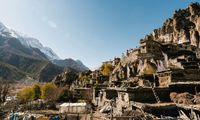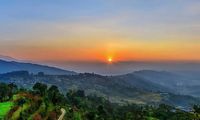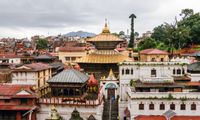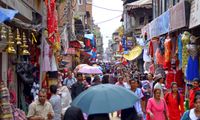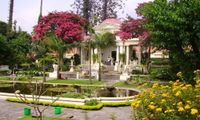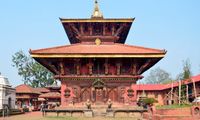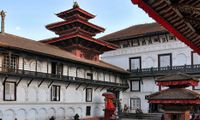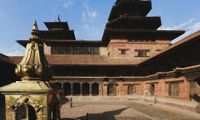Gosaikunda Lake

About
Gosaikunda is a sacred alpine lake located at 4,380 meters in Nepal’s Langtang region. Revered by Hindus and Buddhists alike, this high-altitude destination offers more than just mountain views—it’s a spiritual retreat in the heart of the Himalayas. Whether you're trekking through Langtang National Park or visiting during the Janai Purnima festival, Gosaikunda captivates visitors with its natural serenity, mythological roots, and peaceful highland trails.
Locate Us
Nearby Attractions
Gosaikunda – A Spiritual Himalayan Gem You Must Experience
Tucked away in the Langtang region of Nepal lies Gosaikunda, a high-altitude glacial lake that holds deep spiritual significance and natural beauty. Sitting at 4,380 meters above sea level, Gosaikunda is more than just a trekking destination—it’s a spiritual journey, a scenic escape, and a cultural icon all at once. With clear alpine waters, surrounding snow-capped peaks, and legends rooted in ancient Hindu mythology, it’s a place where nature and divinity merge seamlessly.
Whether you seek peace, adventure, or devotion, Gosaikunda offers an unforgettable experience close to Kathmandu yet far removed from the noise of modern life.
Why Gosaikunda is Famous
A Sacred Pilgrimage Site
Gosaikunda is one of the most revered sites in Nepal for both Hindus and Buddhists. According to Hindu mythology, the lake was formed when Lord Shiva struck his trident into a mountain to release water to cool his poisoned throat. This divine origin gives Gosaikunda immense religious value.
Mythology and Beliefs
Thousands of pilgrims travel here during Janai Purnima, a full moon festival in August, to take a ritual bath in its holy waters. It is believed that bathing in Gosaikunda purifies one’s sins and brings spiritual blessings.
High-Altitude Natural Beauty
The lake’s clear waters reflect the sky and surrounding mountains, creating a surreal visual experience. At sunrise, the light bouncing off the rippling surface is both majestic and meditative.
Top Attractions in and Around Gosaikunda
Gosaikunda Lake
The main lake itself serves as the central attraction of the region. Situated at a lofty altitude of 4,380 meters, its pristine, crystal-clear waters create a stunning contrast against the rugged rocky ridges and the majestic distant peaks that surround it. This breathtaking natural setting offers visitors not only an incredible visual spectacle but also a profound sense of peace and tranquility. Beyond its physical beauty, the lake holds deep spiritual significance, revered as a sacred site where pilgrims come to pray, meditate, and reflect. Its serene ambiance invites introspection and connection with nature, making it an unforgettable destination for both trekkers and spiritual seekers alike.
Other Nearby Lakes
The Gosaikunda basin is home to an extraordinary cluster of more than 108 alpine lakes, each carrying its own unique name and rich legend. Among the most notable are Bhairav Kunda, Saraswati Kunda, and Nag Kunda, each revered in local folklore and spiritual tradition. Venturing beyond the main lake to explore these lesser-known spots allows trekkers to experience a deeper connection with the region’s natural beauty and cultural heritage. This journey through the hidden gems of the basin offers a more immersive and rewarding adventure, revealing tranquil waters, sacred stories, and breathtaking landscapes that few get to witness.
Lauribina La Pass
Perched at an impressive altitude of 4,600 meters, this high mountain pass provides trekkers with breathtaking panoramic views that stretch across some of Nepal’s most iconic peaks. From here, you can marvel at the towering Langtang Lirung, the rugged Ganesh Himal range, and, on clear days, even the distant snow-capped summits of the Manaslu range. The ascent to the pass is steep and challenging, demanding physical endurance and determination, but the effort is richly rewarded with stunning vistas and a true sense of accomplishment. This pass is an ideal destination for those seeking a thrilling high-altitude adventure combined with some of the most awe-inspiring natural scenery in the Himalayas.
Surya Peak Viewpoint
If you’re feeling adventurous and want to push your limits, the optional side hike to Surya Peak, standing at 5,145 meters, is an incredible opportunity. From its summit, you’ll be rewarded with sweeping, bird’s-eye views of the entire Gosaikunda valley, the sparkling alpine lakes scattered throughout, and the majestic mountain ranges that stretch far into the horizon. This challenging yet highly rewarding climb is especially popular among seasoned trekkers looking to extend their journey and soak in some of the most spectacular panoramas the region has to offer.
Langtang National Park
The entire Gosaikunda region falls within Langtang The The entire Gosaikunda region lies within the protected boundaries of Langtang National Park, one of Nepal’s premier conservation areas. This park is renowned for its rich biodiversity, offering a sanctuary to a wide variety of rare and fascinating wildlife. Among its most celebrated inhabitants are the elusive red pandas, vibrant Himalayan monals with their striking plumage, and expansive rhododendron forests that burst into color each spring. Trekking through this pristine natural environment allows visitors to witness not only spectacular landscapes but also the incredible flora and fauna that thrive here, making the Gosaikunda region a true haven for nature lovers and wildlife enthusiasts alike.
How to Get to Gosaikunda from Kathmandu
Via Dhunche
The most common route starts with a 6–7 hour drive from Kathmandu to Dhunche. From here, a steady climb takes you through forests and hamlets up to Gosaikunda. This is the shortest and most direct option.
Via Syabrubesi
A slightly longer and more scenic route begins at Syabrubesi. Though it adds a day or two, the altitude gain is more gradual, making it ideal for better acclimatization.
Via Sundarijal
This adventurous route begins just outside Kathmandu at Sundarijal, passing through Chisapani, Kutumsang, and Lauribina Pass. It offers diverse terrain, fewer crowds, and rich cultural immersion.
Getting There
You can travel by local bus, private jeep, or 4WD. During monsoon or winter, a 4WD is strongly recommended due to rough and muddy roads.
Best Time for Gosaikunda
The Gosaikunda Trek is accessible most of the year, but the experience varies significantly by season. Weather conditions, trail accessibility, crowd levels, and cultural events such as Janai Purnima all play a role in shaping your trek. Below is a seasonal breakdown to help you choose the best time based on your travel goals:
Spring (March to May)
A popular season with blooming flowers and excellent weather.
Pros:
- Clear skies and warm daytime temperatures
- Rhododendron forests in full bloom
- Ideal for panoramic mountain views
Cons:
- Trails may become busy in late April and May
- Popular teahouses may be crowded
Summer / Monsoon (June to August)
Lush and green but with heavy rainfall—best suited for experienced trekkers.
Pros:
- Fewer trekkers, offering a more peaceful experience
- Landscapes turn vibrant and alive with greenery
- Great for attending the Janai Purnima Festival in August
Cons:
- Slippery trails and presence of leeches
- Frequent cloud cover can limit mountain views
- Risk of road blockages due to landslides
Autumn (September to November)
The most recommended season for Gosaikunda trekking.
Pros:
- Stable weather and dry, clear trails
- Crystal-clear views of surrounding peaks
- Comfortable daytime and nighttime temperatures
Cons:
- High season, so expect more trekkers and limited room availability
- Accommodation and transport may be slightly more expensive
Winter (December to February)
Peaceful and scenic but cold and snowy at higher elevations.
Pros:
- Fewer crowds and serene trails
- Snow-covered landscapes and a frozen Gosaikunda Lake for unique photos
Cons:
- Extremely cold, especially at night
- Some teahouses may be closed at higher elevations
- Lauribina Pass may be impassable due to heavy snow
Whether you’re visiting for natural beauty, spiritual significance, or seasonal solitude, timing your trek according to the season ensures a more fulfilling Gosaikunda experience.
Weather Update 2025 for Gosaikunda Trek
Planning your Gosaikunda trek in 2025? Understanding the current weather patterns is key to a safe and enjoyable journey. Here’s the latest weather outlook and conditions to help you prepare:
Spring (March to May):
Spring continues to be one of the best seasons for trekking in the Gosaikunda region. Expect gradually warming temperatures, clear skies, and vibrant rhododendron blooms. Daytime highs typically range from 10°C to 18°C (50°F to 64°F), while nights remain chilly, often dropping close to freezing. Trails are generally dry and accessible, but occasional late snow or rain showers can occur, especially early in the season.
Summer / Monsoon (June to August):
The monsoon season brings heavy rainfall and lush green landscapes, but also increased risks of slippery trails, landslides, and leeches. In 2025, monsoon rains are forecasted to follow the usual pattern, peaking in July. Daytime temperatures range between 15°C and 22°C (59°F to 72°F), with high humidity. Cloud cover often obscures mountain views, but the region’s vibrant flora is at its peak. Trekking during this time is best suited for experienced hikers prepared for wet and challenging conditions.
Autumn (September to November):
Autumn remains the most popular trekking season, thanks to its stable weather and crystal-clear views. In 2025, meteorologists predict a slightly drier than average autumn, offering ideal trekking conditions. Day temperatures usually hover between 12°C and 20°C (54°F to 68°F), with cool, crisp nights. This season is perfect for photographers and nature lovers seeking spectacular vistas and comfortable hiking weather.
Winter (December to February):
Winter in Gosaikunda is cold, with daytime temperatures ranging from -5°C to 8°C (23°F to 46°F), and nights plunging well below freezing, especially at higher elevations. The lake often freezes over, creating stunning icy landscapes. Snowfall is common and may block certain trails, including Lauribina Pass. In 2025, early reports indicate a typical winter pattern, so trekkers should be well-prepared for cold weather gear and possible route adjustments.
Key Tips for 2025:
- Always check updated local weather forecasts before your trek, as mountain conditions can change rapidly.
- Carry layered clothing to adapt to fluctuating temperatures.
- Consider hiring a local guide who stays informed about weather and trail conditions.
- Be prepared for sudden weather shifts, especially in spring and autumn.
Staying informed about the weather will help ensure your Gosaikunda trek is safe, comfortable, and memorable in 2025.
Local Life & Culture
The Gosaikunda region is not only a natural and spiritual marvel but also a vibrant hub of local culture and traditions. The communities here have lived in harmony with the mountains for centuries, preserving unique customs, festivals, and ways of life that enrich every visitor’s experience. Trekking through this area offers more than stunning views—it provides a chance to connect with the warm, hospitable people who call these highlands home.
Locals are often deeply tied to their spiritual beliefs, with many practicing a blend of Hinduism and Buddhism. You’ll witness traditional rituals, prayer flags fluttering on mountain passes, and the gentle ringing of monastery bells in remote villages. The culture here emphasizes respect for nature and community, values that are reflected in the daily lives of residents.
Traditional lifestyles include yak herding, subsistence farming, and artisanal crafts, which add a colorful dimension to the trek. Meeting local families, exploring small villages, and sampling regional foods offer invaluable insight into a way of life shaped by the rugged Himalayan environment.
Local Names & Language Tips
Understanding a few local names and phrases can greatly enhance your trek and interactions with the people of the Gosaikunda region. The primary languages spoken are Tamang, Nepali, and Tibetan dialects, each carrying its own rich heritage.
- Gosaikunda (गोसाइकोंडा): Often called the “Lake of the Saints,” this name reflects the lake’s spiritual significance.
- Lauribina La (लौरीबिना ला): The high mountain pass near Gosaikunda; “La” means pass in Tibetan.
- Tamang (तामाङ्): The dominant ethnic group in the Langtang area, known for their vibrant culture and language.
- “Namaste” (नमस्ते): A universal Nepali greeting meaning “I bow to you,” often accompanied by folded hands.
- “Dhan’yavad” (धन्यवाद): Thank you in Nepali.
- “Tashi Delek” (བཀྲ་ཤིས་བདེ་ལེགས།): A common Tibetan greeting meaning “Good fortune” or “Blessings.”
Simple phrases like these can open doors and create warm connections during your trek. Locals deeply appreciate respectful efforts to engage with their language and culture, making your journey all the more meaningful.
Gosaikunda Trek Difficulty and Altitude
Gosaikunda is a moderate trek, suitable for physically fit individuals—even those without prior high-altitude experience. The trail involves steep ascents, rocky paths, and elevation changes, but no technical climbing.
- Highest elevation: Gosaikunda Lake (4,380m)
- Optional high point: Lauribina Pass (4,600m) or Surya Peak (5,145m)
Altitude Precautions
Proper acclimatization is key. Ascend slowly, stay hydrated, and avoid alcohol. If you're concerned about altitude sickness, choose routes that allow gradual elevation gain.
Gosaikunda Trek Route Map
For a visual overview of the trail, check out the detailed Gosaikunda trek route map available on Trekking Advisor. It highlights major landmarks, trail intersections, and elevation points to help you plan effectively.
Travel Tips for Gosaikunda Visitors
- Pack in layers: Weather can shift quickly. A down jacket, rain shell, and thermal layers are essential.
- Carry cash: No ATMs along the route. Bring enough for snacks, donations, and utilities.
- Respect the culture: Gosaikunda is a religious site—especially during festivals. Dress modestly and behave respectfully.
- Stay safe: Trails can be slippery in monsoon and snowy in winter. Hiring a licensed guide adds safety and cultural insight.
- Avoid altitude issues: Stay hydrated, rest well, and consider extra days for acclimatization.
Photography Tips / Best Viewpoints
- Sunrise at Gosaikunda Lake offers magical reflections and soft golden light—arrive early to capture this moment.
- Lauribina La Pass provides sweeping panoramic shots of Langtang Lirung, Ganesh Himal, and Manaslu peaks.
- Surya Peak summit is perfect for wide-angle views of the entire valley and surrounding mountain ranges.
- Use a polarizing filter to reduce glare from the lake’s surface and enhance sky contrast.
- Carry extra batteries and memory cards; cold weather drains battery life quickly.
Spiritual Traveler Tips
- Respect the sacred nature of Gosaikunda—maintain silence near temples and prayer sites.
- Dress modestly, especially during Janai Purnima and other festivals.
- Participate respectfully in local rituals if invited, but avoid interrupting ceremonies.
- Avoid littering or disturbing natural features considered holy by locals.
- Take time for quiet reflection at the lake’s shore to fully absorb its spiritual ambiance.
Eco-Conscious Travel Tips
- Stick to marked trails to protect fragile alpine vegetation.
- Carry out all your trash and avoid using single-use plastics.
- Use refillable water bottles and purification methods instead of buying bottled water
- Support local businesses and purchase handicrafts directly from artisans.
- Choose licensed guides and responsible tour operators who follow sustainable practices.
Final Thoughts – A Pilgrimage in the Clouds
Gosaikunda is more than a destination—it’s a place of inner peace, natural wonder, and spiritual transformation. Whether you’re hiking for views, meditation, or cultural connection, this sacred lake offers an experience unlike any other in Nepal. Just a few days from Kathmandu, Gosaikunda feels like an entirely different world—silent, sacred, and unforgettable.
Frequently Asked Questions (FAQs)
Q1: How difficult is the Gosaikunda trek?
A: The trek is moderate. It involves steady uphill climbs but no technical sections. Proper fitness and acclimatization help ensure a smooth experience.
Q2: What’s the best time to visit Gosaikunda?
A: Autumn (Sept–Nov) and Spring (Mar–May) are ideal for stable weather and clear views. August is best for the Janai Purnima festival.
Q3: How can I get to Gosaikunda from Kathmandu?
A: You can reach Dhunche, Syabrubesi, or Sundarijal via road (bus or jeep) and start your trek from there based on your preferred route.
Q4: Is Gosaikunda accessible year-round?
A: Yes, but winter can bring snow-covered trails and frozen lakes. Roads may also be blocked during monsoon due to landslides.
Q5: Do I need a permit for Gosaikunda?
A: Yes. You’ll need a TIMS card and Langtang National Park entry permit.
Q6: Is there a Gosaikunda trek route map available?
A: Yes, a downloadable or viewable trek map is available on Trekking Advisor’s route guide section.
Q7: Can beginners do the Gosaikunda trek?
A: Yes, Gosaikunda is considered a moderate trek. While it involves some steep ascents and high altitude, beginners with basic fitness and proper acclimatization can complete it comfortably. Choosing a longer route like via Syabrubesi allows for a gradual ascent.
Q8: Are there teahouses available on the Gosaikunda trail?
A: Yes, there are basic teahouses and lodges available along all major routes to Gosaikunda. They offer local meals, warm beds, and limited amenities. Availability may be lower during winter or off-season, so plan accordingly.
Q9: Do I need to book the trek in advance?
A: Booking is not mandatory but recommended during peak seasons (autumn and spring). Accommodation along the trail is limited, and advance arrangements ensure a smoother experience—especially during Janai Purnima. You can contact Trekking Advisor for a seamless and enjoyable experience.
Q10: Is the Gosaikunda lake always frozen in winter?
A: Yes, during the coldest months (December–February), Gosaikunda Lake typically freezes over, creating a dramatic, icy landscape. It's a serene and mystical sight but also a colder and more challenging trek.
Q11: Can I combine Gosaikunda with other treks?
A: Absolutely. Many trekkers combine Gosaikunda with Langtang Valley, Helambu, or even Tamang Heritage Trail to create a longer circuit through Langtang National Park. Routes can be customized based on your timeframe and interest.
Q12: What should I pack for the Gosaikunda trek?
A: Essentials include warm layered clothing, a sleeping bag, trekking boots, rain gear, snacks, water bottle, and basic first aid. Also carry enough Nepali cash, as there are no ATMs along the trail.
